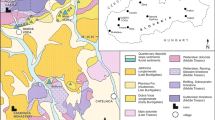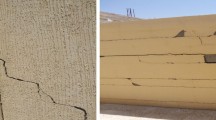Abstract
Ancient Ayla in Aqaba, Jordan was destroyed during a major earthquake incident that occurred in Aqaba in 1067 AD. The Gulf of Aqaba is a seismically active region. The latest strong earthquake incident occurred on November 22, 1995 when an earthquake of local magnitude 6.2 rocked the Gulf of Aqaba region. The main shock was followed by thousands of aftershocks. The Gulf of Aqaba-convering the geologic coordinates 28.0–29.6 N; 34.5–35..2 E is one of two natural bays surrounding the Sinai Peninsula which itself is located at the northernmost end of the Red Sea. The soil profile underlying Aqaba city consists of interlayering of various sedimentory Holocene Alluvium deposits.
This study is aimed at investigating the soil and foundation condition at the site of the ancient Ayla. This includes groundwater conditions, bearing capacity of the strata supporting the walls of ancient Ayla, and structural stability of these walls. The study included an investigation of the characteristics of building stones used in the earlier construction as well as those proposed for use in the restoration of Ancient Ayla. Furthermore, the physical and chemical properties of existing mortars were evaluated. Gradation analyses were conducted to select a proper sand for use in the mortar mix. Mortar mix tests were conducted for the purpose of recommending a mortar mix for use in restoration works. Trends in the results of various mix tests were analyzed.
Sample borings were made at the site to obtain soi profile and extract soil and water samples. Standard Penetration test was conducted at different depths. Laboratory tests were performed on these samples to determine pertinent physical properties of the soil and salinity of the water. Soils at the site were found to be predominantly granular with archaeological fill overlying beach sand which in turn overlies the coarser sand and gravel of the natural deposits. Except for the wadi area, groundwater was encountered at about 3 m below existing ground levels.
Bearing capacity of the foundation was evaluated to be 3.5 kg/cm2 for the dense granular materials (that represent the probable founding layer of the existing walls), and 2.0 kg/cm2 for the weaker silty/clayed zone. Back analysis yields a safe wall height of at least 6.0 m. Therefore, no stability problems are present. Tilting and sinking were noted in some portions of the exterior walls as a result of dynamic lateral earth pressures exerted during the major earthquake incident of 1067 AD. Measures for wall foundation support during archaelogical excavations are suggested. Permanent excavations for exposing the walls should be limited to a free height of about 3 m at the location of western wall, and about 2.5 m at the location of the eastern wall.
Stones used in the construction of ancient Ayla were found to consist of precut sandstone, siltstone, mudstone and granite. Weathering effects were clearly noted on the exposed stones in the walls. It is proposed to use a replacement stone consisting of sandstone group located at a source 35 km North of Aqaba. Measures suggested for the restoration of the walls addressed the lack of mortar in the inner walls and the replacement of disintegrated stone pieces in the external walls.
Existing mortars were found to consist primarily of three types, namely a brown silty mixture, a gray mixture, but predominantly a mixture of fine gravel and a lime/gypsum binder. The major chemical constituents of the original mortar are 18 % SiO2, 23 % CaO, and 34 % SO3. X-ray diffraction peaks indicate the presence of gypsum, calcite and quartz. Comparative analysis data gave 7 % CaCO3, 53 % Sand, and 40 % Solubles as average values of the constituents. Following the selection of two sand sources for use in the mortar mix, recommended mortar for restoration was a mix of lime, sand, ash, with ratios of 1:3:1.5.
Résumé
L’ancienne cité d’Ayla à Aqaba, Jordanie, fut détruite lors d’un tremblement de terre en 1067 avant J.-C. Le golfe d’Aqaba est une région sismiquement active, le dernier tremblement de terre important ayant eu lieu le 22 Novembre 1995, avec une magnitude de 6.2. La secousse principale fut suivie de milliers de répliques. Le golfe d’Aqaba est l’une des deux baies naturelles qui délimitent la péninsule du Sinaï, elle-même située tout au Nord de la Mer Rouge. Le sous-sol d’Aqaba comporte des interstratifications de dépôts alluvionnaires variés de l’Holocène.
La présente étude définit les conditions hydrogéologiques, la capacité portante des niveaux qui supportent les murs de l’ancienne Ayla, ainsi que la stabilité structurale de ces murs. L’étude comporte également l’examen des caractéristiques des pierres de construction d’origine ainsi que de celles qui sont proposés pour la restauration de l’ancienne cité, de même que les propriétés physiques et chimiques des mortiers existants. Des analyses granulométriques ont été effectuées pour sélectionner un sable convenable pour les mortiers de restauration. Ces dernières ont été complétées par des études sur mortiers.
Des échantillons ont été prélevés par sondages à différentes profondeurs, pour mesurer les caractéristiques des sols et la salinité de l’eau. Les sols se sont révélés être essentiellement granulaires, avec présence d’un remblaiement archéologique, au-dessus d’un sable de plage, qui respose lui-même sur des sables et graviers plus grossiers. En dehors de la zone de l’oued, la nappe alluviale se situe à 3 m de profondeur.
La capacité portante de la fondation a été estimée à 3,5 kg/cm2 pour les matériaux granulaires denses et à 2,0 kg/cm2 pour la zone limono-argileuse. On a noté quelques signes d’inclinaison ou d’enfoncement dans certains secteurs des murs extérieurs, résultant de contraintes latérales dynamiques exercées pendant le tremblement de terre de 1067 av. J.-C. Les auteurs suggèrent un certain nombre de mesures à respecta pendant les fouilles archéologiques: l’exposition des murs devrait être limitée à une hauteur de 3 m environ sur l’emplacement du mur Ouest et à environ 2,5 m sur le mur Est.
Les pierres utilisées pour la construction de l’ancienne Ayla se sont révélées être des grès, des pélites, des argilites et des granites taillés. Des signes d’altération sont évidents sur toutes les parties exposées. Un grès dont le gisement se situe à 35 km au Nord d’Aqaba est conseillé comme pierre de restauration.
On observe en place trois types de mortiers: un mélange limineux brun, un mélange grisâtre et surtout un mélange de graviers fins et de liant chaux/gypse. Les constituants chimiques principaux de ce mortier originel sont: 18 % SiO2, 23 % CaO et 34 % SO3. les pics de diffraction des RX indiquent la présence de gypse, de calcite et de quartz. Des analyses comparatives donnent 7 % Co3Ca, 53 % de sable et 40 % de solubles comme valeurs moyennes des constituents. Après avoir sélectionné deux gisements de sable pour la confection du mortier, on recommande comme mortier de restauration un mélange chaux/sable/cendres dans des rapports de 1:3:1,5.
Similar content being viewed by others
References
ASHURST John, 1986: “Mortars, plasters and renders in conservation”, ecclesiastical architects’ and surveyors’ association, middlesex, U.K.
American Standards for Testing and Materials (ASTM), 1983, Annual Book of ASTM Standards, Section 4, Construction, Vol. 04.08, Natural Buildings Stones, Soil and Rock, American Society for Testing and Materials, USA.
BS Standards, 1986, Specifications for Building Sands from Natural Sources.
JEDRZEJEWSKA Hanna, 1981: “Ancient mortars in analyses of old architecture symposium on mortars, cements and grouts used in the conservation of historic buildings”, Rome, Italy.
STEWART John and MOORE James, 1981: “Chemical techniques of historic mortar analysis, symposium on mortars, cements and grouts used in the conservation of historic buildings”, Rome, Italy.
Author information
Authors and Affiliations
Rights and permissions
About this article
Cite this article
Al-Homoud, A.S., Tal, A.B. Soil properties, foundation stability, groundwater conditions, characteristics of building stones and mortar used in construction and proposed measures for restoration at the site of ancient Ayla in a Qaba, Jordan. Bulletin of the International Association of Engineering Geology 55, 53–64 (1997). https://doi.org/10.1007/BF02635408
Published:
Issue Date:
DOI: https://doi.org/10.1007/BF02635408




